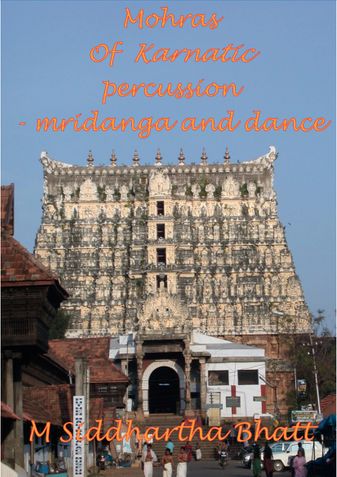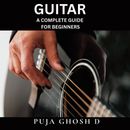You can access the distribution details by navigating to My pre-printed books > Distribution
Mohras of Karnatic percussion-mridanga and dance (eBook)
Moharas of Karnatic percussion- mridangam
Description
This book (720 pages) focusses on the architecture of Mohras which are 4-n avartana faran based sequences positioned at the percussion vortex - termination of the faran rendering section of the tani avartana and just before the beginning of the antima (final) pradhana mukthaya. Mohras are characterized by their straight-forward looping, interlaced and pendulous rhythm creating cascading effects and cardinally punctuated by nada virama farans (farans interwoven with resonant pauses). Mohras are laid out in five or six layers of progressive order consisting of a Mukhya vibaghaa (Main double layered section), Kadita (Reduction double layered section) and a Mukthaya (Termination single layered section). They generally span in size between 24 and 128 chaturashra beats.
Mohras sizes (M) in terms of number of beats can be conveniently represented by an equation of the type M= Ax+By+U, where x is the size of the faran A , y is the size of faran B and U is the uttaranga of the mohra (farans C & D). A, B are the frequency (number of occurrences) of farans A and B. To solve this equation, either y is set equal to x and solved for x; or else y is assigned a fixed value and clubbed with U into a constant and x is then solved. The mohra size which is a 4n multiple of the avartana size is the primary input.
The first chapter gives an introduction to Mohras and their brief classification. In the second chapter, musical metering (tala) and their issues are depicted especially the characteristics and properties of the Suladi saptha talas and their elements. In the third chapter, the raw mridanga sounds and basic building blocks of Karnatic percussion are portrayed along with aspects of pitch characterization and shruti background environment for playing the mridanga.
The fourth chapter is devoted to the basic architecture and principles of Mohras including their taxonomy (vargi karana) and operational aspects such as marshalling for alignment. The structure of the tani avartana is also described. The design and generation of mohras with metric structures (matra anukrama) and ametric structures (amatra anukrama) covering the super-space of the suladi saptha tala system of Karnatic music is described. Generalization of the formulaic design of Mohra type 1 (M=8x+3y+5U) and Mohras type 2 (M=5x+3y+8U= 8x+U) is explained. To improve functionality, the processes of rendering of Mohras of one tala in any other tala, in different grahas (nadana prarambhas) and change of nadai (metric modulation) are elucidated.
The fifth chapter presents the architecture of Mohras which are used in Tani avartana (solo performances) (for commencement of termination of the solo) through a modular and mathematically supported process. The different types of mohras and their generation processes are divided into eight groups. Pre-designed mohras (10 talas sizes) intended to cover the super-set of the Suladi saptha talas are generated. Computation of a mohra required for any avartana sizes is extensively featured. The approach is through development of basic building blocks for mohra construction - faran based sequences used in poorvangas and uttarangas of Mohras and their integration into composite mohras. A number of types of five layered mohra are described. Some six and seven layered mohras and those with large uttaranga sizes from 10 to 32 chaturashra beats are also mathematically described. Some of the other operational aspects are the change of tala of Mohras in Chaturashra nadais from their home tala into other non-home talas; change of nadai in their home tala; and change of both tala and nadai into non-home environments through right alignment (antara sthana); change of nadai of Mohras of metric structures (matra anukramas) using the principle of structural invariance (homomorphism); and Mohras for Adi tala in the 5 different nadais using nadai-tala correspondence (isomorphism). There is a chapter on a glossary of vernacular terms, nomenclature and pronunciation.
In general, the process of generation of mohras for any desired nadai and tala from any other known base tala and nadai through antara sthana (differential start point locator) is described.
The underlying mathematics of the Mohras is reported at their appropriate locations.
The book contains around 45 equations, 90 illustrations and 140 tables. Around 300 mohras are described mathematically and wherever required mnemonically. These are covered by eight groups of mohras based on their structure and generation process (solution of equation or plug-in).
About the Author
Book Details
Ratings & Reviews
Other Books in Music, Performing Arts
Puja Ghosh D
Harsh Baheti
Ali Peter John
Shishir Krishna Sharma





Re: Mohras of Karnatic percussion-mridanga and dance (eBook)
The book deals with the rapid roll Mohras which are rendered before the final mukthayam is rendered in a tani avartanam. The book is monographic in bringing out the different aspects of construction of mohras and covers the mohras for the entire scope of Karnatic music, i.e., the suladi saptha talas. The mathematical aspects and the formulas are well brought out clearly and precisely. The author has done a lot of ground-work for the preparation of this book and I hope this knowledge will be used by many of the practicing and younger generation of percussionists to strengthen Karnatic music and the art of percussion. It was really a pleasure reading this book and whole heartedly recommend this scholarly book to both musicians and budding percussionists.